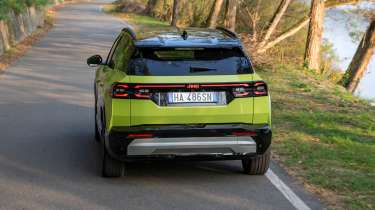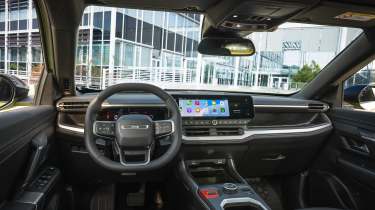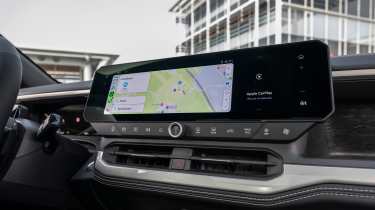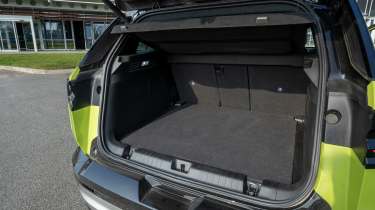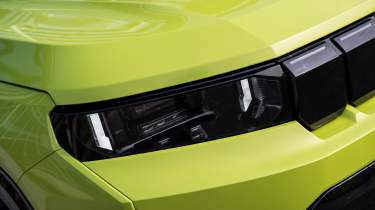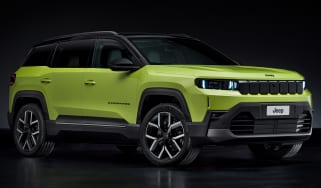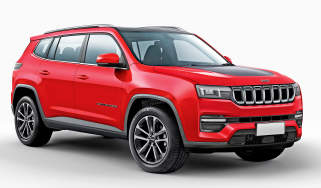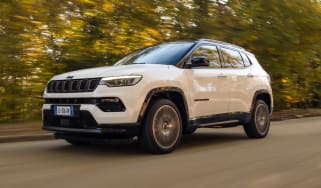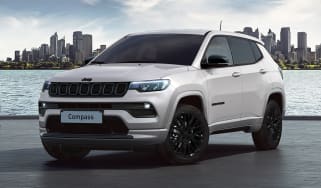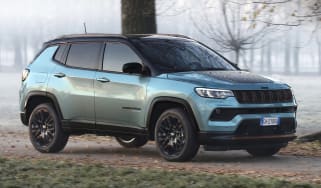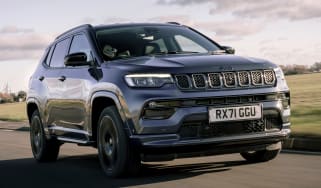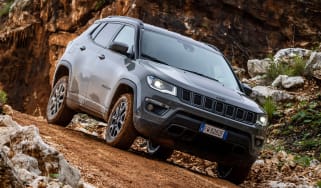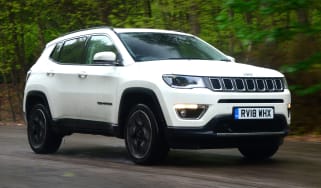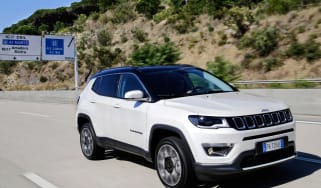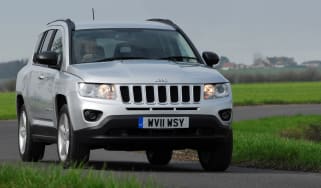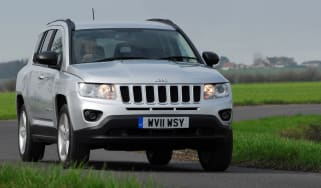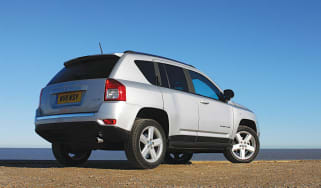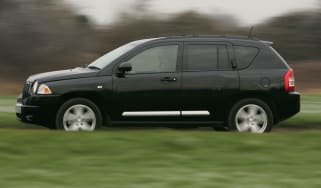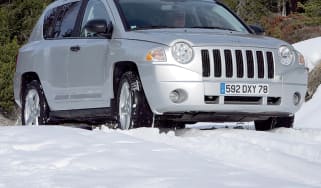Jeep Compass review
The new Jeep Compass has a square-jawed look that’s sure to win fans, but there’s more to this mid-size family SUV than its ruggedly handsome face

Our opinion on the Jeep Compass
The new Jeep Compass capitalises on the enormous success of the smaller Avenger by offering a similar combination of ruggedly handsome looks, an interior built to last, good tech and a wide selection of powertrains that should suit every customer in this segment. Sure, the Compass isn’t as fun to drive as its baby brother, or the plushest mid-size SUV around, but it’s perfectly practical and respects Jeep’s off-road heritage, even if the most treacherous landscape it’s ever likely to see is a gravel car park.
About the Jeep Compass
Since the baby Jeep Avenger arrived a few years ago, more than 200,000 have been snatched up and the brand’s UK sales figures have tripled. So the decision to take the big-seller’s winning formula and super-size it to create the new third-generation Compass is the definition of a no-brainer.
The Jeep Compass is a mid-size family SUV that uses the same STLA Medium platform as the latest Citroen C5 Aircross, Peugeot 3008 and Vauxhall Grandland. Eventually it’ll be available with the same selection of hybrid, plug-in hybrid and pure-electric powertrains as its cousins, too.
Jeep Compass prices and latest deals
Once the Jeep Compass is available to order in entry-level Altitude trim, prices will start from under £35,000 for the hybrid version, and a little over £38,000 for the EV. However, at the time of writing, First Edition specification is the only option, which adds some luxuries and costs about £1,000 more than the equivalent Altitude model.
Used - available now

2020 Jeep
Compass
17,695 milesAutomaticPetrol1.4L
Cash £16,500
2024 Jeep
Compass
37,877 milesAutomaticPetrol1.3L
Cash £15,818
2023 Jeep
Compass
36,595 milesAutomaticPetrol1.3L
Cash £17,710
2020 Jeep
Compass
36,127 milesManualPetrol1.4L
Cash £12,400For context, the Peugeot 3008 starts from nearly £38k, while the E-3008 starts from more than £46k. Meanwhile, the Citroen C5 Aircross is available from £30k and the base E-C5 Aircross costs about £32k – thanks in part to the Government’s Electric Car Grant, which the Jeep isn’t eligible for.
Unfortunately, the new Jeep Compass isn’t available to order or lease through the Auto Express buy a car service just yet, but both its French cousins are. In fact, you can save more than £8,500 on the Citroen C5 Aircross.
Performance & driving experience
Pros |
|
Cons |
|
There will only be one all-wheel-drive version of the latest Compass, which isn’t arriving until 2026 and will be a dual-motor EV. The Vauxhall Grandland is now available with a similar set-up, but the Jeep gets a unique e-motor for the rear axle that can supposedly deliver up to 3,100Nm of torque at the wheels – the perfect amount, we’ve been told, for the car to conquer a 20-degree slope with absolutely no traction on the front wheels.
As well as extra traction, the all-wheel drive Compass 4xe will deliver a combined 370bhp and even greater off-road ability than other versions of the car, thanks to an extra 10mm of ground clearance. That’s still to come though, as are a 191bhp plug-in hybrid version and a long-range variant of the Compass Electric with a 403-mile range.
For now, the Jeep Compass is available with a turbocharged 1.2-litre three-cylinder petrol engine and a six-speed dual-clutch automatic transmission that has a 21bhp electric motor built-in. Or as an EV with a single 210bhp e-motor and 73kWh battery providing up to 310 miles of range. We tried both on the outskirts of Milan in Italy.
| Model | Power | 0-62mph | Top speed |
| Jeep Compass e-Hybrid | 142bhp | 10.3 seconds | 117mph |
| Jeep Compass Electric | 210bhp | 8.5 seconds | 112mph |
Performance, 0-60mph acceleration and top speed
In the hybrid, when you’re not driving on the e-motor (you can tell because the speedo turns blue), the three-pot engine hums away in the background. Put your foot down, and there’s a slight delay until the gearbox finally decides to kick down, then the engine emits a rather gruff drone as you very steadily gain speed. If you need to accelerate hard, such as when joining the motorway, we suggest using the paddles behind the steering wheel to force the gearbox into action.
The electric version provides much smoother acceleration and a generally more refined driving experience – but we did notice some whine from the e-motor when accelerating. The EV’s extra power and more immediate power delivery also chop nearly two seconds off the Compass’s 0-62mph time, although that’s still not enough to make it Tesla quick.
Town driving, visibility and parking
Visibility is decent and the driving position is suitably lofty. The big, heavily sculpted bonnet not only makes you feel like you’re driving a much larger 4x4, the squared edges actually help with placing the car on the road and judging how close you are to stuff, which is particularly helpful in tight situations around town.
This is a relatively easy car to drive around town, in fact, especially the EV with its one-pedal driving ability – something that its Vauxhall, Peugeot and Citroen siblings based on the same platform don’t offer. You do have to be somewhat delicate with the throttle in one-pedal mode to drive the Compass Electric smoothly, but it didn’t take us long to get the hang of it.
Country road driving and handling
The Compass was engineered to cope well with uneven terrain, rather than carving up windy country roads, so there’s quite a bit of body roll when you’re cornering. The steering is accurate and has some weight to it, the brakes offer a good amount of stopping power – as they should – and again there’s no issue placing the car on the road. There is a Sport mode, if you ever fancy it, but we doubt the majority of drivers will.
Motorway driving and long-distance comfort
During our test we found that while the suspension does a decent job of absorbing the impacts from imperfections in the road, the ride feels slightly lumpy, and the car thumps when you drive over potholes and the like. It never fully settles down on the motorway either. We also noticed a fair amount of road noise coming into the cabin in both the hybrid and electric versions.
MPG & running costs
Pros |
|
Cons |
|
If you’re not ready to go electric, or just don’t want the hassle of charging a car, the Compass e-Hybrid is the one for you. Its 1.2-litre petrol engine is paired with a 0.9kWh battery that allows for short periods of pure-electric driving, and it’s charged using energy recuperated from the car slowing down.
According to Jeep, the Compass e-Hybrid can average up to 47.9mpg, and while we haven’t had a chance to cover hundreds of miles to say how accurate that figure is, we did achieve 44.7mpg, which isn’t too far off.
As encouraging as that is, the latest Nissan Qashqai e-Power offers up to 62.8mpg, and we achieved 52.5mpg during our testing. Meanwhile, the equivalent Kia Sportage Hybrid offers up to 50.4mpg, and we saw 43.8mpg when we tested it.
| Model | MPG | CO2 | Insurance group |
| Jeep Compass e-Hybrid | 47.9mpg | 133g//km | TBC |
Electric range, battery life and charge time
Coming in 2026 is the e-Hybrid Plug-In, which will pair a 1.6-litre four-cylinder petrol engine with a single e-motor and a 17.9kWh battery pack. This will offer more than 50 miles of pure-electric driving range, and should be able to return close to 100mpg. However, we haven’t tested this particular version yet and, as with all PHEVs, you’ll need to charge the battery frequently to get the best fuel economy.
The 73kWh battery in the standard Compass Electric offers up to 310 miles of range, which is about the same as the entry-level Tesla Model Y. The long-range version, also coming in 2026, uses an even larger 97kWh battery to deliver up to 403 miles of range, which is further than any variant of the Tesla or Skoda Enyaq. With a peak charging speed of 160kW, refilling either battery from 10 to 80% should take just over half an hour, if you can find a charger capable of such speeds.
| Model | Battery size | Range | Insurance group |
| Jeep Compass e-Hybrid Plug-In | 17.9kWh | 50+ miles | TBC |
| Jeep Compass Electric 73kWh | 73kWh | 310 miles | TBC |
| Jeep Compass Electric 98kWh | 98kWh | 425 miles | TBC |
Tax
Company car drivers will find the Compass Electric the most appealing due to its low 3 per cent Benefit-in-Kind (BiK) company car tax rate, versus 33 per cent for the hybrid model. Meanwhile, for private buyers, we expect most versions of the Compass won’t cost more than £40,000, allowing them to avoid the luxury car tax surcharge for road tax.
Depreciation
According to our most recent expert data, the Jeep Compass should hold onto up to 49 per cent of its original value over a typical three-year/36,000-mile ownership period, with the electric versions being the best performers. The Kia Sportage is also projected to retain up to 49 per cent, as is the Nissan Qashqai.
To get an accurate valuation for a specific model, check out our free car valuation tool...
Interior, design & technology
Pros |
|
Cons |
|
As you can see, all the key Jeep styling traits are present and correct here, including the squared-off wheelarches and the iconic seven-slot grille. It’s blanked-off, like the Avenger’s, but on certain models each segment is illuminated. The front camera is located on the grille too, to hopefully prevent it being damaged by debris.
Eventually, the Compass will be available in Altitude and Summit trim, or Overland and Upland trim if you go for the all-wheel-drive version. The equipment list for each specification hasn’t been confirmed yet, but we do know every Compass will feature a 16-inch touchscreen, wireless Apple CarPlay and Android Auto, LED headlights, cloth seats, keyless entry, adaptive cruise control and various safety systems.
That’s pretty good. However, if you have a chance to buy a First Edition model, we’d jump at it, because they cost only about £1,000 more than the base Altitude version, yet add:
- 20-inch alloy wheels
- Illuminated grille
- Matrix LED headlights
- Heated seats
- Heated steering wheel
- Hands-free tailgate
- Wireless charging pad
Interior and dashboard design
The third-generation Compass is a big step forward in interior design, quality and technology over the previous model. We like the two big clear displays that come in every model, plus the chunky physical buttons on the squared-off steering wheel. The tall centre console also gets a bright red toggle switch for the drive modes and a rotary gear selector that’s well damped, and surprisingly satisfying to use.
Materials and build quality
The leather on the dashboard is a nice touch, and we found everything in the cabin feels sturdy, but there is still a lot of plastic in here.
On one hand, the plastics, thick rubber floor mats and fabric seat upholstery suit this car’s persona, and there are some Jeep ‘easter eggs’ dotted around. However we understand buyers may want a mid-size SUV that looks and feels of higher quality. If that’s you, the Hyundai Tucson, Nissan Qashqai and Volkswagen Tiguan spring immediately to mind.
There were also a few electrical gremlins in the two models we tested. It took several minutes for the head-up display in the first to wake up, and the sunroof in the second refused to do anything. Luckily, it was closed.
Sat-nav, stereo and infotainment
Every model features a 10-inch instrument panel with clear, simple graphics, and a whopping 16-inch touchscreen. Jeep’s latest infotainment system offers lots of functionality with three customisable widgets on the homepage, plus climate controls permanently displayed on either side – even if you connect to Apple CarPlay or Android Auto.
We found menus don’t always load instantly, and you do have to have to be quite precise about how you press or swipe on the homescreen to ensure you interact with the right widget block. Luckily there is a row of shortcut buttons below the display, including one for the ADAS menu that will switch off selected safety systems if you press for long enough.
Boot space & practicality
Pros |
|
Cons |
|
The Compass offers plenty of storage for the detritus that family life generates, with 34 litres worth offered by various trays and cubbies. That includes a handy shelf in front of the passenger, two huge bins in the centre console, and a spot to throw your phone into.
But this being a Jeep, a lot of time and effort has also gone into ensuring the Compass is capable of getting down and dirty. Extremely short overhangs at the front and rear create the best approach, departure and break-over angles of any SUV on this platform. The Jeep also has more than 200mm of ground clearance and a maximum wading depth of 470mm.
True, they’re not exactly key criteria for family SUV buyers, but it’s what people expect from a Jeep and will give them confidence if a festival car park turns into a total quagmire. As do the dedicated ‘Selec-Terrain’ modes for Snow and Sand/Mud, which alter the power delivery and traction control.
Dimensions and size
The third-generation Compass is about 150mm longer than the last model, and its wheelbase is about 130mm longer too, which has provided a big increase in boot space. The Compass is also about the same size as other mid-size SUVs like the Sportage and Qashqai.
| Dimensions Comparison | |||
| Model | Jeep Compass | Kia Sportage | Citroen C5 Aircross |
| Length | 4,552mm | 4,540mm | 4,652mm |
| Width | 1,928mm | 1,865mm | 1,936mm |
| Height | 1,675mm | 1,645mm | 1,688-1,691mm |
| Wheelbase | 2,795mm | 2,680mm | 2,784mm |
| Boot space | 550 litres | 526-591 litres | 565-650 litres |
Seats & passenger space
The back seats offer more than enough legroom for six-feet-tall adults, as well as adequate headroom – a benefit of the car’s boxy shape. The rear floor is a little higher than other mid-size SUVs, but we assume that’s in order to accommodate the battery pack in the EV, and passengers have space to stretch out, including room under the front seats to tuck their feet.
We think you could just about squeeze three people onto the rear seats, or if you have small children, there are two sets of ISOFIX mounting points on the outer seats covered by zips.
Boot space
The Compass offers 550 litres of boot space, which is 45 litres more than the previous model and puts it in the middle of the mid-size SUV pack. The Nissan Qashqai offers up to 504 litres, for instance, while the Kia Sportage has a 587-litre load area. At least the EV offers the same amount of cargo space, and there’s room under the boot floor for the charging cables.
Reliability & safety
Pros |
|
Cons |
|
The third-generation Jeep Compass hasn’t received a crash safety score from Euro NCAP yet, but it’s likely to get the same four out of five stars as the Vauxhall Grandland, Citroen C5 Aircross and Peugeot 3008, because they’re all based on the same STLA Medium platform.
Every Compass is equipped with adaptive cruise control and lane-keeping assist, which means it offers Level 2 autonomous driving ability. Automatic Emergency Braking, plus front and rear parking sensors are also standard, however a reversing camera isn’t.
Thankfully you can add a 360-degree camera system, plus blind-spot detection and extra parking sensors, with the £700 Convenience Pack. There’s also a £1,500 ADAS pack, which bundles rear cross-traffic alert, blind-spot detection, a head-up display and other tech.
Jeep only managed to finish 26th (out of 31 brands) in the most recent Driver Power best car manufacturer rankings, putting it behind other members of the Stellantis family including Fiat (21st), Citroen (16th), Peugeot (7th) and Vauxhall (4th). Thanks to a low number of responses, Alfa Romeo and DS weren’t included in the list.
Buying and owning
Best buy: Jeep Compass Electric First Edition
While not everyone is ready to go electric, the zero-emission version of the Jeep Compass offers a more refined driving experience than the e-Hybrid, plus it’s just as practical and delivers a decent amount of range. Meanwhile in First Edition trim, the Compass comes with most of the kit you’ll probably want in a family SUV and doesn’t cost that much more than the entry-level Altitude model.
Jeep Compass alternatives
The Jeep Compass faces stiff competition from loads of mid-size SUVs, including those related to it, such as the Citroen C5 Aircross, which prioritises comfort and value. Its other cousins are the spacious Vauxhall Grandland and the stylish Peugeot 3008.
The Nissan Qashqai remains a strong all-rounder, especially with its newly improved e-Power hybrid powertrain, and Google tech now onboard. The Kia Sportage is more practical, though, and it recently received a fresh new look, inside and out.
Meanwhile, the Hyundai Tucson offers refinement, space and hybrid technology in a head-turning package with a great-feeling interior. But if you want an even more sophisticated feel to your next family SUV, the Volkswagen Tiguan is the way to go.
Frequently Asked Questions
The Jeep Compass remains a left-field choice in the mid-size SUV segment, but this latest iteration is the most capable yet. It’s practical, available with a selection of electrified powertrains and has the ruggedly handsome look people want from a Jeep.
Deals on the Compass and alternatives



